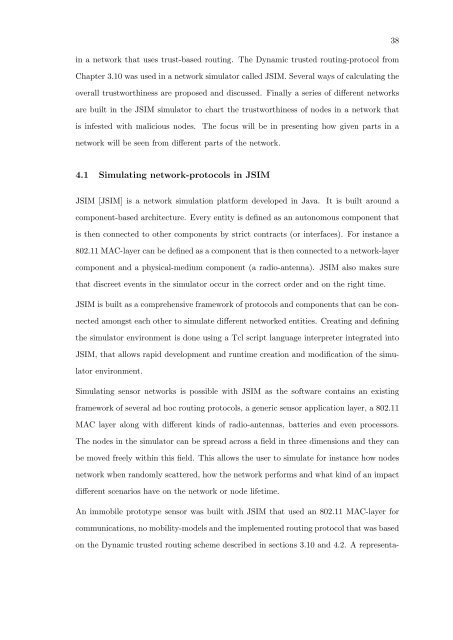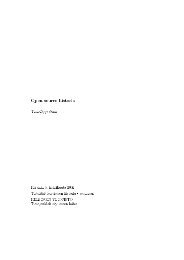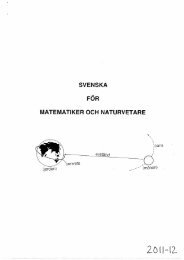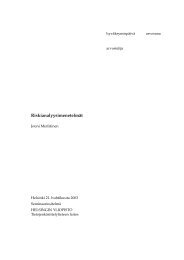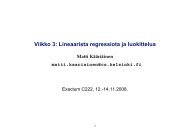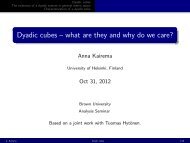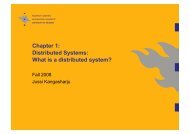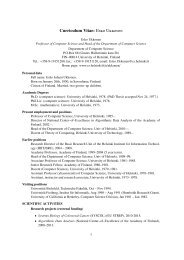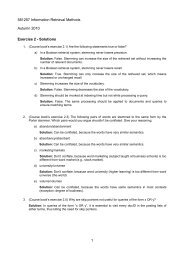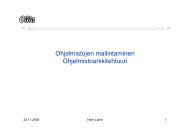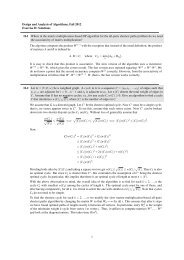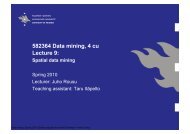Calculating trust in sensor networks
Calculating trust in sensor networks
Calculating trust in sensor networks
You also want an ePaper? Increase the reach of your titles
YUMPU automatically turns print PDFs into web optimized ePapers that Google loves.
<strong>in</strong> a network that uses <strong>trust</strong>-based rout<strong>in</strong>g. The Dynamic <strong>trust</strong>ed rout<strong>in</strong>g-protocol from<br />
Chapter 3.10 was used <strong>in</strong> a network simulator called JSIM. Several ways of calculat<strong>in</strong>g the<br />
overall <strong>trust</strong>worth<strong>in</strong>ess are proposed and discussed. F<strong>in</strong>ally a series of different <strong>networks</strong><br />
are built <strong>in</strong> the JSIM simulator to chart the <strong>trust</strong>worth<strong>in</strong>ess of nodes <strong>in</strong> a network that<br />
is <strong>in</strong>fested with malicious nodes. The focus will be <strong>in</strong> present<strong>in</strong>g how given parts <strong>in</strong> a<br />
network will be seen from different parts of the network.<br />
4.1 Simulat<strong>in</strong>g network-protocols <strong>in</strong> JSIM<br />
JSIM [JSIM] is a network simulation platform developed <strong>in</strong> Java. It is built around a<br />
component-based architecture. Every entity is def<strong>in</strong>ed as an autonomous component that<br />
is then connected to other components by strict contracts (or <strong>in</strong>terfaces). For <strong>in</strong>stance a<br />
802.11 MAC-layer can be def<strong>in</strong>ed as a component that is then connected to a network-layer<br />
component and a physical-medium component (a radio-antenna). JSIM also makes sure<br />
that discreet events <strong>in</strong> the simulator occur <strong>in</strong> the correct order and on the right time.<br />
JSIM is built as a comprehensive framework of protocols and components that can be con-<br />
nected amongst each other to simulate different networked entities. Creat<strong>in</strong>g and def<strong>in</strong><strong>in</strong>g<br />
the simulator environment is done us<strong>in</strong>g a Tcl script language <strong>in</strong>terpreter <strong>in</strong>tegrated <strong>in</strong>to<br />
JSIM, that allows rapid development and runtime creation and modification of the simu-<br />
lator environment.<br />
Simulat<strong>in</strong>g <strong>sensor</strong> <strong>networks</strong> is possible with JSIM as the software conta<strong>in</strong>s an exist<strong>in</strong>g<br />
framework of several ad hoc rout<strong>in</strong>g protocols, a generic <strong>sensor</strong> application layer, a 802.11<br />
MAC layer along with different k<strong>in</strong>ds of radio-antennas, batteries and even processors.<br />
The nodes <strong>in</strong> the simulator can be spread across a field <strong>in</strong> three dimensions and they can<br />
be moved freely with<strong>in</strong> this field. This allows the user to simulate for <strong>in</strong>stance how nodes<br />
network when randomly scattered, how the network performs and what k<strong>in</strong>d of an impact<br />
different scenarios have on the network or node lifetime.<br />
An immobile prototype <strong>sensor</strong> was built with JSIM that used an 802.11 MAC-layer for<br />
communications, no mobility-models and the implemented rout<strong>in</strong>g protocol that was based<br />
on the Dynamic <strong>trust</strong>ed rout<strong>in</strong>g scheme described <strong>in</strong> sections 3.10 and 4.2. A representa-<br />
38


